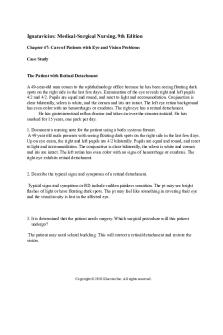Assault causing actual bodily harm Section 47 PDF

| Title | Assault causing actual bodily harm Section 47 |
|---|---|
| Course | Criminal Law |
| Institution | Middlesex University London |
| Pages | 2 |
| File Size | 48 KB |
| File Type | |
| Total Downloads | 52 |
| Total Views | 152 |
Summary
Assault causing actual bodily harm Section 47...
Description
Assault causing actual bodily harm Section 47: Offences Against the Persons act 1861 Actus Reus of section 47 1) An Assault or Battery 2) Actual Body Harm 3) Causation a) In fact b) In law There must an assault: Actus Reus and Mens rea for either battery or assault Must be established that the assault or battery caused the actual bodily harm “Actual Bodily Harm” = Any hurt or injury calculated to interfere with the health or comfort of the victim.’ It was said that the hurt need not be serious or permanent but must be more than transient and trifling “Actual” = does not need to be permanent, can also be Psychiatric injury (medical evidence required) Case: DPP v Smith Actual bodily harm cases - Case: Brown; Includes physical injury that it not transitory or trifling - Case: Ireland & Burstow - Psychiatric injury can be bodily harm - Case: Venna: Broken finger and fractured bone - Case: T v DPP: Loss of consciousness was sufficient. - Case: DPP v Smith: Cutting of someones ponytail without consent Mens Rea of section 47 No mens rea is required for the actual bodily harm. Only need assault or battery. No different to assault / battery
Section 20: Offences Against the Persons act 1861 “ It is an offence to ‘unlawfully and maliciously wound or inflict GBH on another person” Actus Reus of Section 20 Defendant unlawfully wounds or unlawfully inflicts GBH 1) To Wound The whole skin must be broken (Case: Moriarty v Brookes) Internal rupture of blood vessels does not constitute to a wound (Case: Eisenhower) A cut or laceration is a wound. 2) Inflicting Case: Wilson - GBH may be inflicted … either where the defendant has directly and violently "inflicted" it by assaulting the victim, or where the accused has "inflicted" it by doing something. - E.g. applying force. Case: Burstow - Charged with inflicting GBH by means of silent telephone calls to V, Hate mail, theft of clothing from her washing line and scattering condoms in her garden which gave her severe depressions. - Infliction without insult, where no physical violence is applied directly / indirectly to the body of the victim - If serious enough, psychiatric harm may be GBH.
Case: Mowatt - Mens rea does not correspond to the actus reus, the prosecution does not have to prove D intended the wound / GBH or foresaw it. It is enough for the prosecution to prove D foresaw some harm. 3) Gross Bodily Harm Case: DPP v Smith - Grievous bodily harm means ‘really serious harm’ and is a question of fact for the jury. - Example of GBH: - Substantial loss of blood, needing a transfusion - Lengthy treatment or incapacity - Permanent disability or loss of sensory function - Disfigurement - Broken or displaced limbs or bones, fractured skull - Broken cheek bone, jaw, ribs. Mens Rea of Section 20 Defendant must maliciously intend or reckless as to the causing of some harm Case: R v Savage, Parmenter - No need to prove that D intended to cause actual bodily harm or was reckless. - Wounding does not necessarily involve an assault - Prosecution needs to prove that the defendant foresaw that some physical harm might result from his actions. Cunningham recklessness test 1) An actual intention to do a particular harm that was done 2) Recklessness as to whether such hard would occur or not (and has gone on to do it)...
Similar Free PDFs

Assault Causing death s 25A
- 2 Pages

Mental Harm -Torts - Notes
- 6 Pages

Assault Cases
- 3 Pages

Assault Flowchart
- 8 Pages

Criminal Assault
- 2 Pages

Common assault
- 4 Pages

Battery and Assault
- 2 Pages

Assault Battery and ABH
- 15 Pages

Bodily Fluids Case Paper
- 6 Pages

Chapter 29 Sexual Assault
- 9 Pages

Duty of Care (Psychiatric Harm)
- 5 Pages
Popular Institutions
- Tinajero National High School - Annex
- Politeknik Caltex Riau
- Yokohama City University
- SGT University
- University of Al-Qadisiyah
- Divine Word College of Vigan
- Techniek College Rotterdam
- Universidade de Santiago
- Universiti Teknologi MARA Cawangan Johor Kampus Pasir Gudang
- Poltekkes Kemenkes Yogyakarta
- Baguio City National High School
- Colegio san marcos
- preparatoria uno
- Centro de Bachillerato Tecnológico Industrial y de Servicios No. 107
- Dalian Maritime University
- Quang Trung Secondary School
- Colegio Tecnológico en Informática
- Corporación Regional de Educación Superior
- Grupo CEDVA
- Dar Al Uloom University
- Centro de Estudios Preuniversitarios de la Universidad Nacional de Ingeniería
- 上智大学
- Aakash International School, Nuna Majara
- San Felipe Neri Catholic School
- Kang Chiao International School - New Taipei City
- Misamis Occidental National High School
- Institución Educativa Escuela Normal Juan Ladrilleros
- Kolehiyo ng Pantukan
- Batanes State College
- Instituto Continental
- Sekolah Menengah Kejuruan Kesehatan Kaltara (Tarakan)
- Colegio de La Inmaculada Concepcion - Cebu




